Possibilities, Challenges, and Future Opportunities of Microgrids: A Review
Abstract
1. Introduction
2. Literature Review
2.1. Microgrids’ Potential Benefits
- Increased reliability: Microgrids operate independently, so they can continue to provide power even if the main grid fails.
- Reduced energy costs: Microgrids can combine renewable energy sources and energy storage to reduce energy costs and improve energy efficiency.
- Improved energy security: Microgrids can provide a secure power source in areas where the main grid is unreliable or expensive.
- Environmental benefits: Microgrids can reduce carbon emissions by using renewable energy sources, which can help to mitigate climate change.
- Increased flexibility: Microgrids can be configured to meet the specific needs of the local community and expanded or reconfigured as needed.
2.2. Microgrids’ Potential Areas for Growth and Research
2.2.1. Blockchain Technology, Artificial Intelligence, and Machine Learning in Microgrids
2.2.2. Microgrids and EV Integration
2.3. Global Sustainability Issues and Microgrid Development
2.4. Critical Aspects in Microgrid Development
3. Challenges of Microgrid Implementation
3.1. Cybersecurity Issues
3.2. Energy Storage Issues
3.3. Social Equity Concerns
3.4. Financial Concerns
3.5. Environmental Concerns
4. Technical Aspects of MGs Implementation
4.1. Harmonics and Power Quality
4.2. Microgrid Stability
4.3. Microgrid Energy Storage
4.4. Microgrid Control Strategies
4.5. Microgrid Protection Strategies
5. Microgrids in Pakistan: A Case Study
5.1. Pakistan’s Energy Mix
5.2. Energy Sector of Pakistan
5.3. Net Metering
5.4. Economical Impacts of Microgrid Projects in Pakistan
5.5. Environmental Aspects of Microgrid Projects in Pakistan
5.6. Limitations in Pakistan
5.6.1. Cost
5.6.2. Scalability
5.6.3. Sophisticated Electronic Devices
5.6.4. Lack of Technical Skills
5.6.5. Regulatory Challenges
5.6.6. Government Policies
5.6.7. Microgrids’ Future Scope in Pakistan
6. Discussion
7. Conclusions
Author Contributions
Funding
Data Availability Statement
Conflicts of Interest
References
- Ekanayake, U.N.; Navaratne, U.S. A Survey on Microgrid Control Techniques in Islanded Mode. J. Electr. Comput. Eng. 2020, 2020, 6275460. [Google Scholar] [CrossRef]
- Kumar, G.V.B.; Palanisamy, K. A Review of Energy Storage Participation for Ancillary Services in a Microgrid Environment. Inventions 2020, 5, 63. [Google Scholar] [CrossRef]
- Debouza, M.; Al-Durra, A.; El-Fouly, T.H.; Zeineldin, H.H. Survey on microgrids with flexible boundaries: Strategies, applications, and future trends. Electr. Power Syst. Res. 2022, 205, 107765. [Google Scholar] [CrossRef]
- López-Prado, J.L.; Vélez, J.I.; Garcia-Llinás, G.A. Reliability Evaluation in Distribution Networks with Microgrids: Review and Classification of the Literature. Energies 2020, 13, 6189. [Google Scholar] [CrossRef]
- Amrutha Raju, B.; Vuddanti, S.; Salkuti, S.R. Review of Energy Management System Approaches in Microgrids. Energies 2021, 14, 5459. [Google Scholar] [CrossRef]
- Ansari, S.; Chandel, A.; Tariq, M. A Comprehensive Review on Power Converters Control and Control Strategies of AC/DC Microgrid. IEEE Access 2020, 9, 17998–18015. [Google Scholar] [CrossRef]
- Rebollal, D.; Carpintero-Rentería, M.; Santos-Martín, D.; Chinchilla, M. Microgrid and Distributed Energy Resources Standards and Guidelines Review: Grid Connection and Operation Technical Requirements. Energies 2021, 14, 523. [Google Scholar] [CrossRef]
- Gao, K.; Wang, T.; Han, C.; Xie, J.; Ma, Y.; Peng, R. A Review of Optimization of Microgrid Operation. Energies 2021, 14, 2842. [Google Scholar] [CrossRef]
- Roslan, M.; Hannan, M.; Ker, P.J.; Mannan, M.; Muttaqi, K.; Mahlia, T.I. Microgrid control methods toward achieving sustainable energy management: A bibliometric analysis for future directions. J. Clean. Prod. 2022, 348, 131340. [Google Scholar] [CrossRef]
- Shahgholian, G. A brief review on microgrids: Operation, applications, modeling, and control. Int. Trans. Electr. Energy Syst. 2021, 31, e12885. [Google Scholar] [CrossRef]
- Wei, C.; Shen, Z.; Xiao, D.; Wang, L.; Bai, X.; Chen, H. An optimal scheduling strategy for peer-to-peer trading in interconnected microgrids based on RO and Nash bargaining. Appl. Energy 2021, 295, 117024. [Google Scholar] [CrossRef]
- Arcos-Aviles, D.; Guinjoan, F.; Pascual, J.; Marroyo, L.; Sanchis, P.; Gordillo, R.; Ayala, P.; Marietta, M.P. A Review of Fuzzy-Based Residential Grid-Connected Microgrid Energy Management Strategies for Grid Power Profile Smoothing. In Energy Sustainability in Built and Urban Environments; Springer: Berlin/Heidelberg, Germany, 2018; pp. 165–199. [Google Scholar] [CrossRef]
- Cagnano, A.; De Tuglie, E.; Mancarella, P. Microgrids: Overview and guidelines for practical implementations and operation. Appl. Energy 2019, 258, 114039. [Google Scholar] [CrossRef]
- Choudhury, S. A comprehensive review on issues, investigations, control and protection trends, technical challenges and future directions for Microgrid technology. Int. Trans. Electr. Energy Syst. 2020, 30, e12446. [Google Scholar] [CrossRef]
- Ali, S.; Zheng, Z.; Aillerie, M.; Sawicki, J.-P.; Péra, M.-C.; Hissel, D. A Review of DC Microgrid Energy Management Systems Dedicated to Residential Applications. Energies 2021, 14, 4308. [Google Scholar] [CrossRef]
- Fontenot, H.; Dong, B. Modeling and control of building-integrated microgrids for optimal energy management—A review. Appl. Energy 2019, 254, 113689. [Google Scholar] [CrossRef]
- Lopez-Garcia, T.B.; Coronado-Mendoza, A.; Domínguez-Navarro, J.A. Artificial neural networks in microgrids: A review. Eng. Appl. Artif. Intell. 2020, 95, 103894. [Google Scholar] [CrossRef]
- Wang, Y.; Rousis, A.O.; Strbac, G. On microgrids and resilience: A comprehensive review on modeling and operational strategies. Renew. Sustain. Energy Rev. 2020, 134, 110313. [Google Scholar] [CrossRef]
- Mishra, M.; Chandak, S.; Rout, P.K. Taxonomy of Islanding detection techniques for distributed generation in microgrid. Renew. Energy Focus 2019, 31, 9–30. [Google Scholar] [CrossRef]
- Derks, M.; Romijn, H. Sustainable performance challenges of rural microgrids: Analysis of incentives and policy framework in Indonesia. Energy Sustain. Dev. 2019, 53, 57–70. [Google Scholar] [CrossRef]
- Kirchhoff, H.; Strunz, K. Key drivers for successful development of peer-to-peer microgrids for swarm electrification. Appl. Energy 2019, 244, 46–62. [Google Scholar] [CrossRef]
- Dawood, F.; Shafiullah, G.; Anda, M. Stand-Alone Microgrid with 100% Renewable Energy: A Case Study with Hybrid Solar PV-Battery-Hydrogen. Sustainability 2020, 12, 2047. [Google Scholar] [CrossRef]
- Adefarati, T.; Obikoya, G. Assessment of Renewable Energy Technologies in a Standalone Microgrid System. Int. J. Eng. Res. Afr. 2020, 46, 146–167. [Google Scholar] [CrossRef]
- Kumar, A.; Sah, B.; Singh, A.R.; Deng, Y.; He, X.; Kumar, P.; Bansal, R. Multicriteria decision-making methodologies and their applications in sustainable energy system/microgrids. In Decision Making Applications in Modern Power Systems; Academic Press: Cambridge, MA, USA, 2019; pp. 1–40. [Google Scholar] [CrossRef]
- Barik, A.K.; Das, D.C. Integrated resource planning in sustainable energy-based distributed microgrids. Sustain. Energy Technol. Assessments 2021, 48, 101622. [Google Scholar] [CrossRef]
- Arfeen, Z.A.; Khairuddin, A.B.; Larik, R.M.; Saeed, M.S. Control of distributed generation systems for microgrid applications: A technological review. Int. Trans. Electr. Energy Syst. 2019, 29, e12072. [Google Scholar] [CrossRef]
- Hannan, M.; Faisal, M.; Ker, P.J.; Begum, R.; Dong, Z.; Zhang, C. Review of optimal methods and algorithms for sizing energy storage systems to achieve decarbonization in microgrid applications. Renew. Sustain. Energy Rev. 2020, 131, 110022. [Google Scholar] [CrossRef]
- Sahoo, B.; Routray, S.K.; Rout, P.K. AC, DC, and hybrid control strategies for smart microgrid application: A review. Int. Trans. Electr. Energy Syst. 2020, 31, e12683. [Google Scholar] [CrossRef]
- Tomin, N.; Shakirov, V.; Kozlov, A.; Sidorov, D.; Kurbatsky, V.; Rehtanz, C.; Lora, E.E.S. Design and optimal energy management of community microgrids with flexible renewable energy sources. Renew. Energy 2022, 183, 903–921. [Google Scholar] [CrossRef]
- Nejabatkhah, F.; Li, Y.W.; Liang, H.; Ahrabi, R.R. Cyber-Security of Smart Microgrids: A Survey. Energies 2020, 14, 27. [Google Scholar] [CrossRef]
- Rasool, M.; Khan, M.A.; Tahir, S. Optimal On-Grid Hybrid AC/DC Microgrid for a Small Village in Muzaffargarh District, Pakistan. In Proceedings of the 2021 International Conference on Emerging Power Technologies (ICEPT), Topi, Pakistan, 10–11 April 2021; pp. 1–8. [Google Scholar] [CrossRef]
- Batiyah, S.; Sharma, R.; Abdelwahed, S.; Alhosaini, W.; Aldosari, O. Predictive Control of PV/Battery System under Load and Environmental Uncertainty. Energies 2022, 15, 4100. [Google Scholar] [CrossRef]
- Peddakapu, K.; Mohamed, M.; Srinivasarao, P.; Arya, Y.; Leung, P.; Kishore, D. A state-of-the-art review on modern and future developments of AGC/LFC of conventional and renewable energy-based power systems. Renew. Energy Focus 2022, 43, 146–171. [Google Scholar] [CrossRef]
- Barik, A.K.; Jaiswal, S.; Das, D.C. Recent trends and development in hybrid microgrid: A review on energy resource planning and control. Int. J. Sustain. Energy 2021, 41, 308–322. [Google Scholar] [CrossRef]
- Alzahrani, A.; Sajjad, K.; Hafeez, G.; Murawwat, S.; Khan, S.; Khan, F.A. Real-time energy optimization and scheduling of buildings integrated with renewable microgrid. Appl. Energy 2023, 335, 120640. [Google Scholar] [CrossRef]
- Xu, J.; Yi, Y. Multi-microgrid low-carbon economy operation strategy considering both source and load uncertainty: A Nash bargaining approach. Energy 2023, 263, 125712. [Google Scholar] [CrossRef]
- Lei, B.; Ren, Y.; Luan, H.; Dong, R.; Wang, X.; Liao, J.; Fang, S.; Gao, K. A Review of Optimization for System Reliability of Microgrid. Mathematics 2023, 11, 822. [Google Scholar] [CrossRef]
- Alam, S.; Al-Ismail, F.S.; Al-Sulaiman, F.A.; Abido, M.A. Energy management in DC microgrid with an efficient voltage compensation mechanism. Electr. Power Syst. Res. 2023, 214, 108842. [Google Scholar] [CrossRef]
- Fazal, S.; Haque, E.; Arif, M.T.; Gargoom, A.; Oo, A.M.T. Grid integration impacts and control strategies for renewable based microgrid. Sustain. Energy Technol. Assess. 2023, 56, 103069. [Google Scholar] [CrossRef]
- Vita, V.; Fotis, G.; Pavlatos, C.; Mladenov, V. A New Restoration Strategy in Microgrids after a Blackout with Priority in Critical Loads. Sustainability 2023, 15, 1974. [Google Scholar] [CrossRef]
- Farrokhabadi, M.; Canizares, C.A.; Simpson-Porco, J.W.; Nasr, E.; Fan, L.; Mendoza-Araya, P.A.; Tonkoski, R.; Tamrakar, U.; Hatziargyriou, N.D.; Lagos, D.; et al. Microgrid Stability Definitions, Analysis, and Examples. IEEE Trans. Power Syst. 2019, 35, 13–29. [Google Scholar] [CrossRef]
- Yang, F.; Feng, X.; Li, Z. Advanced Microgrid Energy Management System for Future Sustainable and Resilient Power Grid. IEEE Trans. Ind. Appl. 2019, 55, 7251–7260. [Google Scholar] [CrossRef]
- Shayeghi, H.; Shahryari, E.; Moradzadeh, M.; Siano, P. A Survey on Microgrid Energy Management Considering Flexible Energy Sources. Energies 2019, 12, 2156. [Google Scholar] [CrossRef]
- Yang, J.; Su, C. Robust optimization of microgrid based on renewable distributed power generation and load demand uncertainty. Energy 2021, 223, 120043. [Google Scholar] [CrossRef]
- Kumar, P.S.; Chandrasena, R.P.S.; Ramu, V.; Srinivas, G.N.; Babu, K.V.S.M. Energy Management System for Small Scale Hybrid Wind Solar Battery Based Microgrid. IEEE Access 2020, 8, 8336–8345. [Google Scholar] [CrossRef]
- Muhtadi, A.; Pandit, D.; Nguyen, N.; Mitra, J. Distributed Energy Resources Based Microgrid: Review of Architecture, Control, and Reliability. IEEE Trans. Ind. Appl. 2021, 57, 2223–2235. [Google Scholar] [CrossRef]
- Bandeiras, F.; Pinheiro, E.; Gomes, M.; Coelho, P.; Fernandes, J. Review of the cooperation and operation of microgrid clusters. Renew. Sustain. Energy Rev. 2020, 133, 110311. [Google Scholar] [CrossRef]
- Adefarati, T.; Bansal, R. Reliability, economic and environmental analysis of a microgrid system in the presence of renewable energy resources. Appl. Energy 2018, 236, 1089–1114. [Google Scholar] [CrossRef]
- Baloch, S.; Muhammad, M.S. An Intelligent Data Mining-Based Fault Detection and Classification Strategy for Microgrid. IEEE Access 2021, 9, 22470–22479. [Google Scholar] [CrossRef]
- Chandak, S.; Rout, P.K. The implementation framework of a microgrid: A review. Int. J. Energy Res. 2020, 45, 3523–3547. [Google Scholar] [CrossRef]
- Gulzar, M.M.; Iqbal, M.; Shahzad, S.; Muqeet, H.A.; Shahzad, M.; Hussain, M.M. Load Frequency Control (LFC) Strategies in Renewable Energy-Based Hybrid Power Systems: A Review. Energies 2022, 15, 3488. [Google Scholar] [CrossRef]
- Tobajas, J.; Garcia-Torres, F.; Roncero-Sánchez, P.; Vázquez, J.; Bellatreche, L.; Nieto, E. Resilience-oriented schedule of microgrids with hybrid energy storage system using model predictive control. Appl. Energy 2021, 306, 118092. [Google Scholar] [CrossRef]
- Sinha, S.; Bajpai, P. Power management of hybrid energy storage system in a standalone DC microgrid. J. Energy Storage 2020, 30, 101523. [Google Scholar] [CrossRef]
- Tooryan, F.; HassanzadehFard, H.; Collins, E.R.; Jin, S.; Ramezani, B. Smart integration of renewable energy resources, electrical, and thermal energy storage in microgrid applications. Energy 2020, 212, 118716. [Google Scholar] [CrossRef]
- Lagrange, A.; de Simón-Martín, M.; González-Martínez, A.; Bracco, S.; Rosales-Asensio, E. Sustainable microgrids with energy storage as a means to increase power resilience in critical facilities: An application to a hospital. Int. J. Electr. Power Energy Syst. 2020, 119, 105865. [Google Scholar] [CrossRef]
- Daneshvar, M.; Mohammadi-Ivatloo, B.; Zare, K.; Asadi, S. Transactive energy management for optimal scheduling of interconnected microgrids with hydrogen energy storage. Int. J. Hydrogen Energy 2020, 46, 16267–16278. [Google Scholar] [CrossRef]
- Ahmed, M.; Meegahapola, L.; Vahidnia, A.; Datta, M. Stability and Control Aspects of Microgrid Architectures–A Comprehensive Review. IEEE Access 2020, 8, 144730–144766. [Google Scholar] [CrossRef]
- Al-Ismail, F.S. DC Microgrid Planning, Operation, and Control: A Comprehensive Review. IEEE Access 2021, 9, 36154–36172. [Google Scholar] [CrossRef]
- Saxena, V.; Kumar, N.; Singh, B.; Panigrahi, B.K. An MPC Based Algorithm for a Multipurpose Grid Integrated Solar PV System With Enhanced Power Quality and PCC Voltage Assist. IEEE Trans. Energy Convers. 2021, 36, 1469–1478. [Google Scholar] [CrossRef]
- Shahzad, S.; Abbasi, M.A.; Chaudhry, M.A.; Hussain, M.M. Model Predictive Control Strategies in Microgrids: A Concise Revisit. IEEE Access 2022, 10, 122211–122225. [Google Scholar] [CrossRef]
- Yang, W.; Kang, X.; Wang, X.; Wang, M. MPC-based three-phase unbalanced power coordination control method for microgrid clusters. Energy Rep. 2023, 9, 1830–1841. [Google Scholar] [CrossRef]
- Dagar, A.; Gupta, P.; Niranjan, V. Microgrid protection: A comprehensive review. Renew. Sustain. Energy Rev. 2021, 149, 111401. [Google Scholar] [CrossRef]
- Beheshtaein, S.; Cuzner, R.M.; Forouzesh, M.; Savaghebi, M.; Guerrero, J.M. DC Microgrid Protection: A Comprehensive Review. IEEE J. Emerg. Sel. Top. Power Electron. 2019, 1, 2904588. [Google Scholar] [CrossRef]
- Chandra, A.; Singh, G.K.; Pant, V. Protection techniques for DC microgrid- A review. Electr. Power Syst. Res. 2020, 187, 106439. [Google Scholar] [CrossRef]
- Patnaik, B.; Mishra, M.; Bansal, R.C.; Jena, R.K. AC microgrid protection—A review: Current and future prospective. Appl. Energy 2020, 271, 115210. [Google Scholar] [CrossRef]
- Khan, R.; Khan, A. Cost Optimization of Hybrid Microgrid across China-Pakistan Economic Corridor (CPEC) Eastern Route for Rural Electrification in Pakistan. In Proceedings of the 2019 3rd International Conference on Energy Conservation and Efficiency (ICECE), Lahore, Pakistan, 23–24 October 2019. [Google Scholar] [CrossRef]
- Baig, M.J.A.; Iqbal, M.T.; Jamil, M.; Khan, J. Design and Analysis of an Isolated DC-Microgrid for a Remote Community in Pakistan. In Proceedings of the 2021 IEEE 12th Annual Ubiquitous Computing, Electronics & Mobile Communication Conference (UEMCON), New York, NY, USA, 1–4 December 2021; pp. 712–716. [Google Scholar] [CrossRef]
- Khan, S.N.; Kazmi, S.A.A. Integrative decision-making framework for techno-economic planning and sustainability assessment of renewable dominated standalone hybrid microgrids infrastructure at provincial scale of Pakistan. Energy Convers. Manag. 2022, 270, 116168. [Google Scholar] [CrossRef]
- Khan, M.A.; Aziz, M.S.; Khan, A.; Zeb, K.; Uddin, W.; Ishfaq, M. An Optimized Off-gird Renewable AC/DC Microgrid for Remote Communities of Pakistan. In Proceedings of the 2019 International Conference on Electrical, Communication, and Computer Engineering (ICECCE), Swat, Pakistan, 24–25 July 2019. [Google Scholar] [CrossRef]
- Sattar, M.; Azeem, F.; Memon, Z.; Zidan, H.; Baig, S. Feasibility Assessment of Rural Hybrid Microgrid Using Canal-Based Microhydel Resources: A Case Study of Renala Khurd Pakistan. Sustainability 2022, 14, 15417. [Google Scholar] [CrossRef]
- Shah, S.A.A.; Solangi, Y.A. A sustainable solution for electricity crisis in Pakistan: Opportunities, barriers, and policy implications for 100% renewable energy. Environ. Sci. Pollut. Res. 2019, 26, 29687–29703. [Google Scholar] [CrossRef]
- Shahid, M.; Ullah, K.; Imran, K.; Mahmood, I.; Mahmood, A. Electricity supply pathways based on renewable resources: A sustainable energy future for Pakistan. J. Clean. Prod. 2020, 263, 121511. [Google Scholar] [CrossRef]
- Shabbir, N.; Usman, M.; Jawad, M.; Zafar, M.H.; Iqbal, M.N.; Kütt, L. Economic analysis and impact on national grid by domestic photovoltaic system installations in Pakistan. Renew. Energy 2020, 153, 509–521. [Google Scholar] [CrossRef]
- Yousuf, M.U.; Abbasi, M.A.; Kashif, M.; Umair, M. Energy, exergy, economic, environmental, energoeconomic, exergoeconomic, and enviroeconomic (7E) analyses of wind farms: A case study of Pakistan. Environ. Sci. Pollut. Res. 2022, 29, 67301–67324. [Google Scholar] [CrossRef]
- Pakistan-Countries & Region-IEA. Available online: https://www.iea.org/countries/pakistan (accessed on 18 January 2023).
- NEPRA | Home. Available online: https://www.nepra.org.pk/ (accessed on 18 January 2023).
- National Transmission & Despatch Company Limited (Ntdc) Pakistan. Available online: https://ntdc.gov.pk/merit-order (accessed on 19 March 2023).
- Saeed, M.K.; Salam, A.; Rehman, A.U. Comparison of six different methods of Weibull distribution for wind power assessment: A case study for a site in the Northern region of Pakistan. Sustain. Energy Technol. Assess. 2019, 36, 100541. [Google Scholar] [CrossRef]
- Mengal, A.; Mirjat, N.H.; Das Walasai, G.; Khatri, S.A.; Harijan, K.; Uqaili, M.A. Modeling of Future Electricity Generation and Emissions Assessment for Pakistan. Processes 2019, 7, 212. [Google Scholar] [CrossRef]
- Salam, R.A.; Amber, K.P.; Ratyal, N.I.; Alam, M.; Akram, N.; Muñoz, C.Q.G.; Márquez, F.P.G. An Overview on Energy and Development of Energy Integration in Major South Asian Countries: The Building Sector. Energies 2020, 13, 5776. [Google Scholar] [CrossRef]
- Raza, M.Y.; Wasim, M.; Sarwar, M.S. Development of Renewable Energy Technologies in rural areas of Pakistan. Energy Sources, Part A: Recover. Util. Environ. Eff. 2019, 42, 740–760. [Google Scholar] [CrossRef]
- Ullah, K.; Raza, M.S.; Mirza, F.M. Barriers to hydro-power resource utilization in Pakistan: A mixed approach. Energy Policy 2019, 132, 723–735. [Google Scholar] [CrossRef]
- Malik, S.; Qasim, M.; Saeed, H.; Chang, Y.; Taghizadeh-Hesary, F. Energy security in Pakistan: Perspectives and policy implications from a quantitative analysis. Energy Policy 2020, 144, 111552. [Google Scholar] [CrossRef]
- Irfan, M.; Zhao, Z.-Y.; Rehman, A.; Ozturk, I.; Li, H. Consumers’ intention-based influence factors of renewable energy adoption in Pakistan: A structural equation modeling approach. Environ. Sci. Pollut. Res. 2020, 28, 432–445. [Google Scholar] [CrossRef]
- Menhas, R.; Mahmood, S.; Tanchangya, P.; Safdar, M.N.; Hussain, S. Sustainable Development under Belt and Road Initiative: A Case Study of China-Pakistan Economic Corridor’s Socio-Economic Impact on Pakistan. Sustainability 2019, 11, 6143. [Google Scholar] [CrossRef]
- Uddin, R.; Shaikh, A.; Khan, H.; Shirazi, M.; Rashid, A.; Qazi, S. Renewable Energy Perspectives of Pakistan and Turkey: Current Analysis and Policy Recommendations. Sustainability 2021, 13, 3349. [Google Scholar] [CrossRef]
- Iqbal, W.; Yumei, H.; Abbas, Q.; Hafeez, M.; Mohsin, M.; Fatima, A.; Jamali, M.A.; Jamali, M.; Siyal, A.; Sohail, N. Assessment of Wind Energy Potential for the Production of Renewable Hydrogen in Sindh Province of Pakistan. Processes 2019, 7, 196. [Google Scholar] [CrossRef]
- Mahmood, A.; Wang, X.; Shahzad, A.; Fiaz, S.; Ali, H.; Naqve, M.; Javaid, M.; Mumtaz, S.; Naseer, M.; Dong, R. Perspectives on Bioenergy Feedstock Development in Pakistan: Challenges and Opportunities. Sustainability 2021, 13, 8438. [Google Scholar] [CrossRef]
- Malik, M.Z.; Baloch, M.H.; Ali, B.; Khahro, S.H.; Soomro, A.M.; Abbas, G.; Zhang, S. Power Supply to Local Communities Through Wind Energy Integration: An Opportunity Through China-Pakistan Economic Corridor (CPEC). IEEE Access 2021, 9, 66751–66768. [Google Scholar] [CrossRef]
- Ahmad, U.S.; Usman, M.; Hussain, S.; Jahanger, A.; Abrar, M. Determinants of renewable energy sources in Pakistan: An overview. Environ. Sci. Pollut. Res. 2022, 29, 29183–29201. [Google Scholar] [CrossRef] [PubMed]
- Qasim, M.; Ahmad, S.; Shoukat, A. World Adoption of Renewable Energy and the Role of Pakistan in Green Energy Production. In Proceedings of the 2022 International Conference on Technology and Policy in Energy and Electric Power (ICT-PEP), Jakarta, Indonesia, 18–20 October 2022; pp. 139–144. [Google Scholar] [CrossRef]
- Hassan, M.; Afridi, M.K.; Khan, M.I. Energy policies and environmental security: A multi-criteria analysis of energy policies of Pakistan. Int. J. Green Energy 2019, 16, 510–519. [Google Scholar] [CrossRef]
- Raza, M.A.; Aman, M.M.; Abro, A.G.; Tunio, M.A.; Khatri, K.L.; Shahid, M. Challenges and potentials of implementing a smart grid for Pakistan’s electric network. Energy Strat. Rev. 2022, 43, 100941. [Google Scholar] [CrossRef]
- Ahmed, T.; Yaqoob, M.A.; Sultan, W.; Latif, M.H.; Khlaid, W.; Shah, I.A. Financial Impact of Energy Efficient Retrofits on Design of Grid Tied Solar Systems in Pakistan. In Proceedings of the 2019 International Conference on Electrical, Communication, and Computer Engineering (ICECCE), Swat, Pakistan, 24–25 July 2019. [Google Scholar] [CrossRef]
- Rauf, A.; Al-Awami, A.T.; Kassas, M.; Khalid, M. Optimal Sizing and Cost Minimization of Solar Photovoltaic Power System Considering Economical Perspectives and Net Metering Schemes. Electronics 2021, 10, 2713. [Google Scholar] [CrossRef]
- Qazi, U.; Iqbal, S.; Zaheer, H.; Ur, R.T. Prepaid metering: A way forward for sustainable power sector in Pakistan. Energy Strat. Rev. 2020, 31, 100546. [Google Scholar] [CrossRef]
- Jamal, H.; Butt, Y.; Basit, A.; Ramay, M.B.Z.; Rafay, A.; Tariq, M.Z.; Zia, Z.; Ahmed, H.I. Designing of Smart Net Energy Meter with Multi-Mode Tariff Computations for the Diverse Energy Prosumers in Pakistan. In Proceedings of the 2020 IEEE 23rd International Multitopic Conference (INMIC), Bahawalpur, Pakistan, 5–7 November 2020; pp. 1–6. [Google Scholar] [CrossRef]
- Danish, M.S.S.; Matayoshi, H.; Howlader, H.R.; Chakraborty, S.; Mandal, P.; Senjyu, T.; Danish, M.S.S. Microgrid Planning and Design: Resilience to Sustainability. In Proceedings of the 2019 IEEE PES GTD Grand International Conference and Exposition Asia (GTD Asia), Bangkok, Thailand, 19–23 March 2019; pp. 253–258. [Google Scholar]
- Muhammad, S.; Ullah, I. Spatial and seasonal variation of water quality indices in Gomal Zam Dam and its tributaries of south Waziristan District, Pakistan. Environ. Sci. Pollut. Res. 2022, 29, 29141–29151. [Google Scholar] [CrossRef]
- Afzal, J.; Yihong, Z.; Qayum, M.; Afzal, U.; Aslam, M. Effects of dam on temperature, humidity and precipitation of surrounding area: A case study of Gomal Zam Dam in Pakistan. Environ. Sci. Pollut. Res. 2022, 30, 14592–14603. [Google Scholar] [CrossRef]
- Shaikh, A.; Shaikh, P.H.; Kumar, L.; Mirjat, N.H.; Memon, Z.A.; Assad, M.E.H.; Alayi, R. Design and Modeling of a Grid-Connected PV–WT Hybrid Microgrid System Using Net Metering Facility. Iran. J. Sci. Technol. Trans. Electr. Eng. 2022, 46, 1189–1205. [Google Scholar] [CrossRef]
- Habib, H.U.R.; Waqar, A.; Junejo, A.K.; Ismail, M.M.; Hossen, M.; Jahangiri, M.; Kabir, A.; Khan, S.; Kim, Y.-S. Optimal Planning of Residential Microgrids Based on Multiple Demand Response Programs Using ABC Algorithm. IEEE Access 2022, 10, 116564–116626. [Google Scholar] [CrossRef]
- Abbasi, A.; Sultan, K.; Aziz, M.A.; Khan, A.U.; Khalid, H.A.; Guerrero, J.M.; Zafar, B.A. A Novel Dynamic Appliance Clustering Scheme in a Community Home Energy Management System for Improved Stability and Resiliency of Microgrids. IEEE Access 2021, 9, 142276–142288. [Google Scholar] [CrossRef]
- Abbas, S.Z.; Ali, Z.; Mahmood, A.; Haider, S.Q.; Kousar, A.; Razzaq, S.; Hassan, T.U.; Su, C.-L. Review of Smart Grid and Nascent Energy Policies: Pakistan as a Case Study. Energies 2022, 15, 7044. [Google Scholar] [CrossRef]
- Tahir, S.; Khan, M.A.; Rasool, M.; Naseer, N. An Optimized Off-grid Renewable Micro-Grid Design and Feasibility Analysis for Remote Industries of Gadoon Swabi (Pakistan). In Proceedings of the 2021 International Conference on Artificial Intelligence and Mechatronics Systems (AIMS), Bandung, Indonesia, 28–30 April 2021; pp. 1–6. [Google Scholar] [CrossRef]
- Memon, J.A.; Hussain, A. Consumer (Co-)ownership in renewables in Pakistan. In Energy Transition: Financing Consumer Co-Ownership in Renewables; Springer: Berlin/Heidelberg, Germany, 2019; pp. 611–635. [Google Scholar] [CrossRef]
- Hassan, Q. Evaluation and optimization of off-grid and on-grid photovoltaic power system for typical household electrification. Renew. Energy 2020, 164, 375–390. [Google Scholar] [CrossRef]
- Aziz, M.S.; Khan, M.A.; Khan, A.; Nawaz, F.; Imran, M.; Siddique, A. Rural Electrification through an Optimized Off-grid Microgrid based on Biogas, Solar, and Hydro Power. In Proceedings of the 2020 International Conference on Engineering and Emerging Technologies (ICEET), Lahore, Pakistan, 22–23 February 2020; pp. 1–5. [Google Scholar] [CrossRef]
- Ahmad, M.; Khan, A.; Raza, M.A.; Khan, M.A.; Rehman, M.A. Study, Design and Analysis of an Optimized Off-gird Renewable AC/DC microgrid for a Rural School in Swabi, Pakistan. In Proceedings of the2019 22nd International Multitopic Conference (INMIC), Islamabad, Pakistan, 29–30 November 2019. [Google Scholar] [CrossRef]
- Sarangi, S.; Sahu, B.K.; Rout, P.K. A comprehensive review of distribution generation integratedDCmicrogrid protection: Issues, strategies, and future direction. Int. J. Energy Res. 2020, 45, 5006–5031. [Google Scholar] [CrossRef]
- Fotis, G.; Dikeakos, C.; Zafeiropoulos, E.; Pappas, S.; Vita, V. Scalability and Replicability for Smart Grid Innovation Projects and the Improvement of Renewable Energy Sources Exploitation: The FLEXITRANSTORE Case. Energies 2022, 15, 4519. [Google Scholar] [CrossRef]
- Razmi, D.; Lu, T. A Literature Review of the Control Challenges of Distributed Energy Resources Based on Microgrids (MGs): Past, Present and Future. Energies 2022, 15, 4676. [Google Scholar] [CrossRef]
- Blesslin, S.T.; Wessley, G.J.J.; Kanagaraj, V.; Kamatchi, S.; Radhika, A.; Janeera, D. Microgrid Optimization and Integration of Renewable Energy Resources: Innovation, Challenges and Prospects. In Integration of Renewable Energy Sources with Smart Grid; Wiley: Hoboken, NJ, USA, 2021; pp. 239–262. [Google Scholar] [CrossRef]
- Hossain, A.; Pota, H.R.; Hossain, J.; Blaabjerg, F. Evolution of microgrids with converter-interfaced generations: Challenges and opportunities. Int. J. Electr. Power Energy Syst. 2019, 109, 160–186. [Google Scholar] [CrossRef]
- Habib, H.U.R.; Wang, S.; Elmorshedy, M.F.; Waqar, A.; Imran, R.M.; Kotb, K.M. Performance Enhancement of Power Converters for PV-Based Microgrid using Model Predictive Control. In Proceedings of the 2019 International Conference on Electrical, Communication, and Computer Engineering (ICECCE), Swat, Pakistan, 24–25 July 2019. [Google Scholar] [CrossRef]
- Latief, R.; Lefen, L. Foreign Direct Investment in the Power and Energy Sector, Energy Consumption, and Economic Growth: Empirical Evidence from Pakistan. Sustainability 2019, 11, 192. [Google Scholar] [CrossRef]
- Kashif, M.; Awan, M.; Nawaz, S.; Amjad, M.; Talib, B.; Farooq, M.; Nizami, A.; Rehan, M. Untapped renewable energy potential of crop residues in Pakistan: Challenges and future directions. J. Environ. Manag. 2019, 256, 109924. [Google Scholar] [CrossRef]
- Baloch, Z.A.; Tan, Q.; Kamran, H.W.; Nawaz, M.A.; Albashar, G.; Hameed, J. A multi-perspective assessment approach of renewable energy production: Policy perspective analysis. Environ. Dev. Sustain. 2021, 24, 2164–2192. [Google Scholar] [CrossRef]
- Guo, S.; He, Y.; Pei, H.; Wu, S. The multi-objective capacity optimization of wind-photovoltaic-thermal energy storage hybrid power system with electric heater. Sol. Energy 2019, 195, 138–149. [Google Scholar] [CrossRef]
- Aized, T.; Rehman, S.M.S.; Sumair, M. Pakistan energy situation, policy, and issues. In Recent Advances in Renewable Energy Technologies; Academic Press: Cambridge, MA, USA, 2021; pp. 387–428. [Google Scholar] [CrossRef]
- Irfan, M.; Zhao, Z.-Y.; Panjwani, M.K.; Mangi, F.H.; Li, H.; Jan, A.; Ahmad, M.; Rehman, A. Assessing the energy dynamics of Pakistan: Prospects of biomass energy. Energy Rep. 2019, 6, 80–93. [Google Scholar] [CrossRef]
- Yousaf, A.; Khan, B.A.; Bashir, U.; Ahmad, F. Overview of Implementing Microgrid, Its Policies, Incentives and Challenges in Pakistan. In Proceedings of the 2019 6th International Conference on Electrical and Electronics Engineering (ICEEE), Istanbul, Turkey, 12 August 2019. [Google Scholar] [CrossRef]
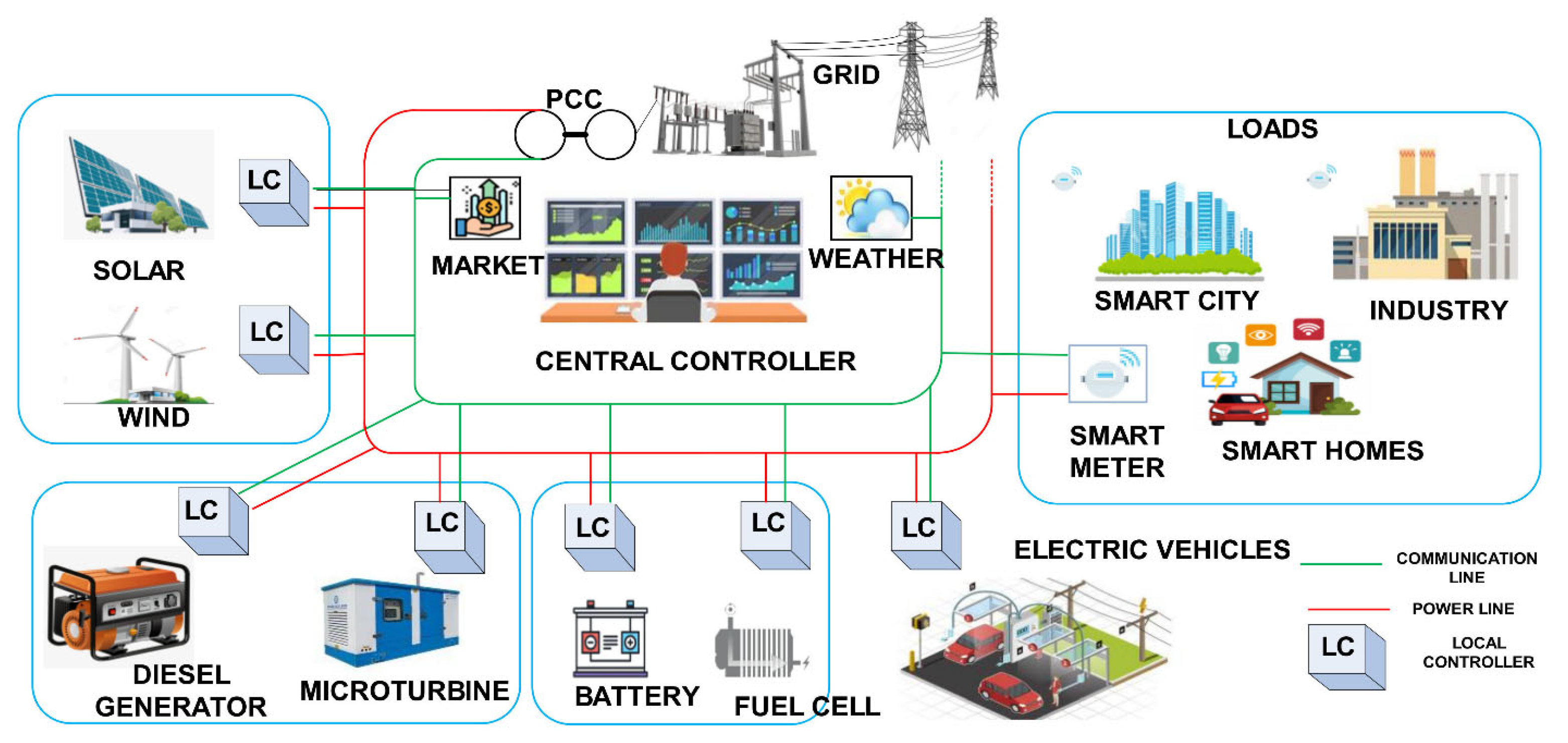
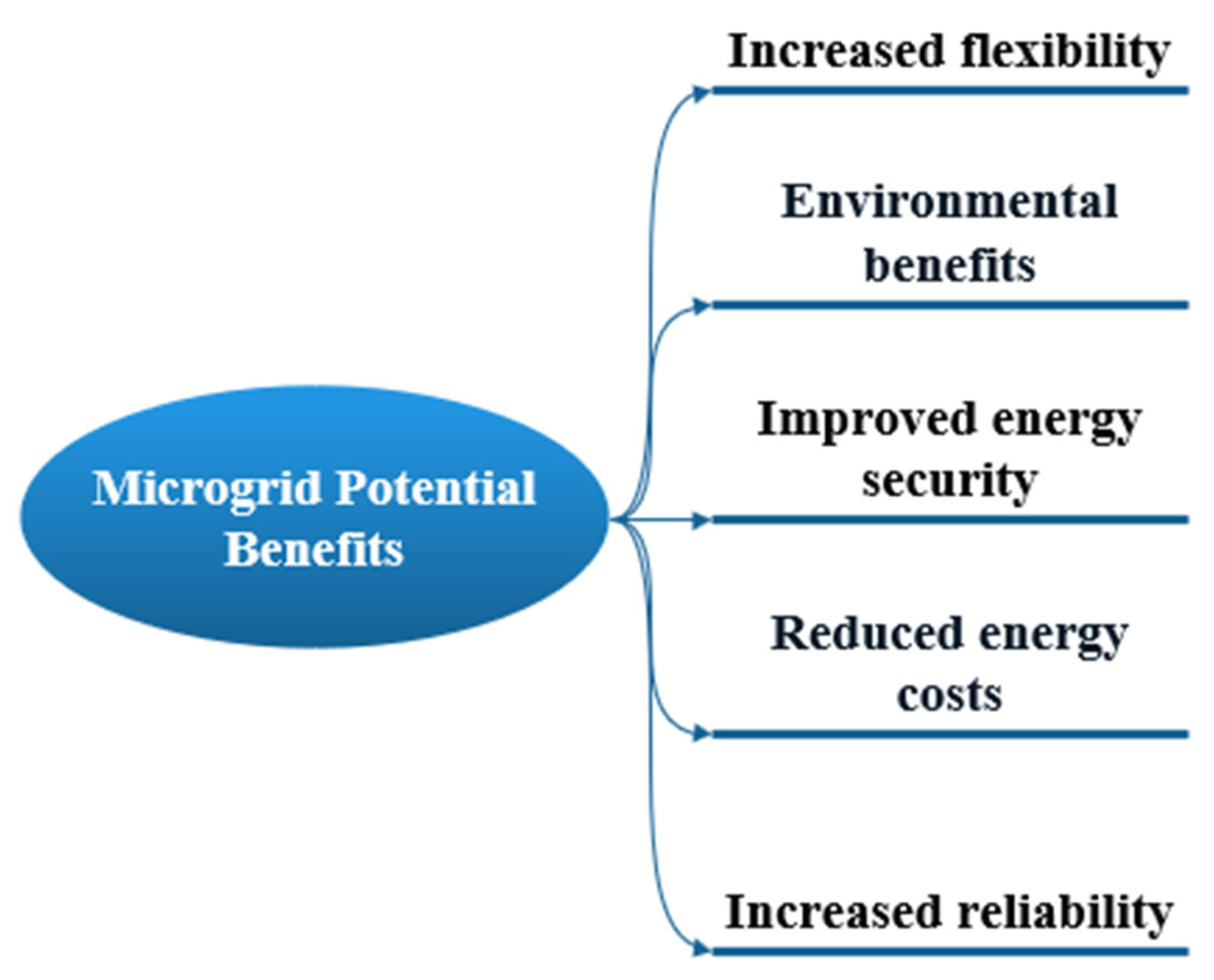
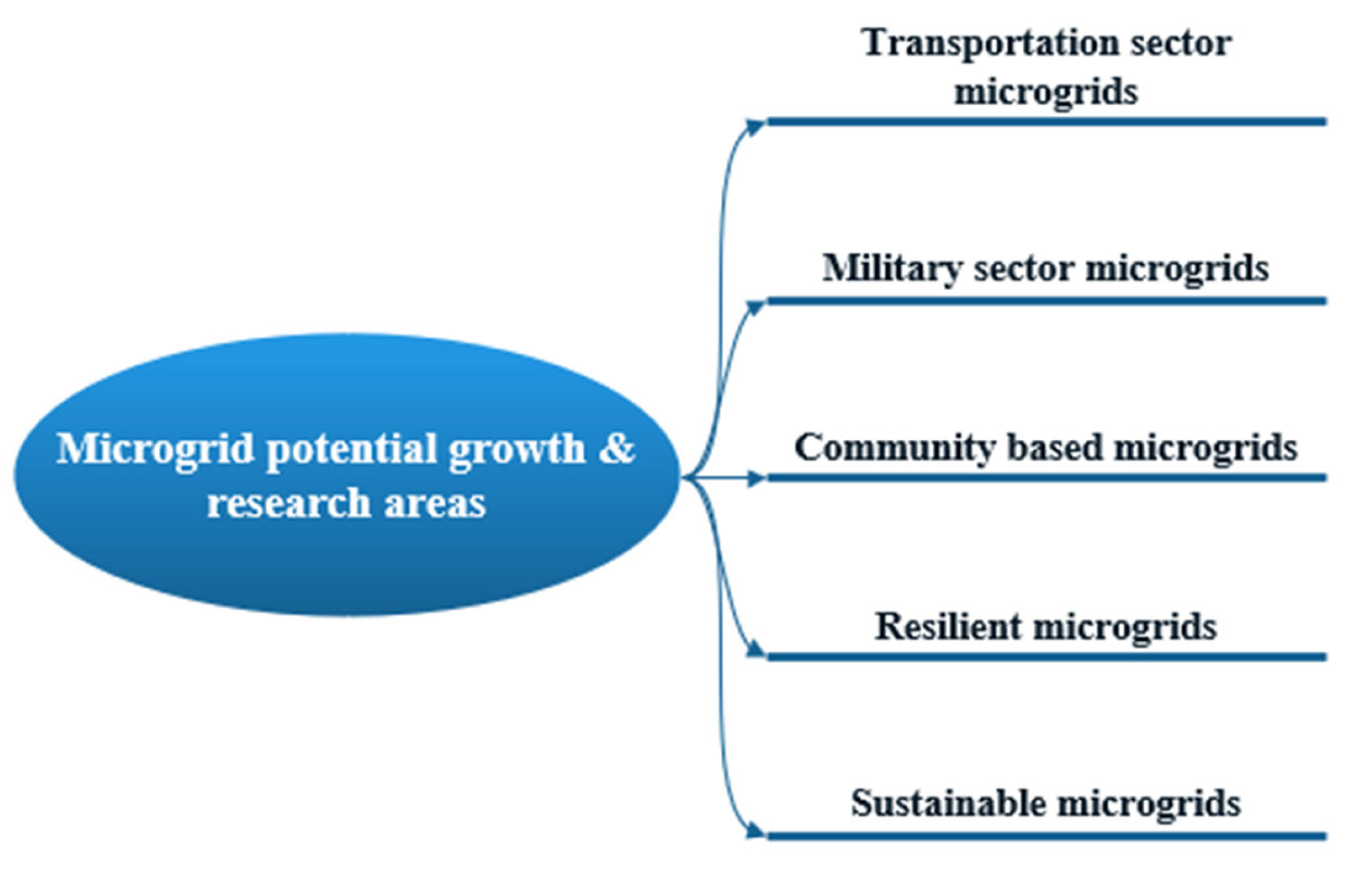
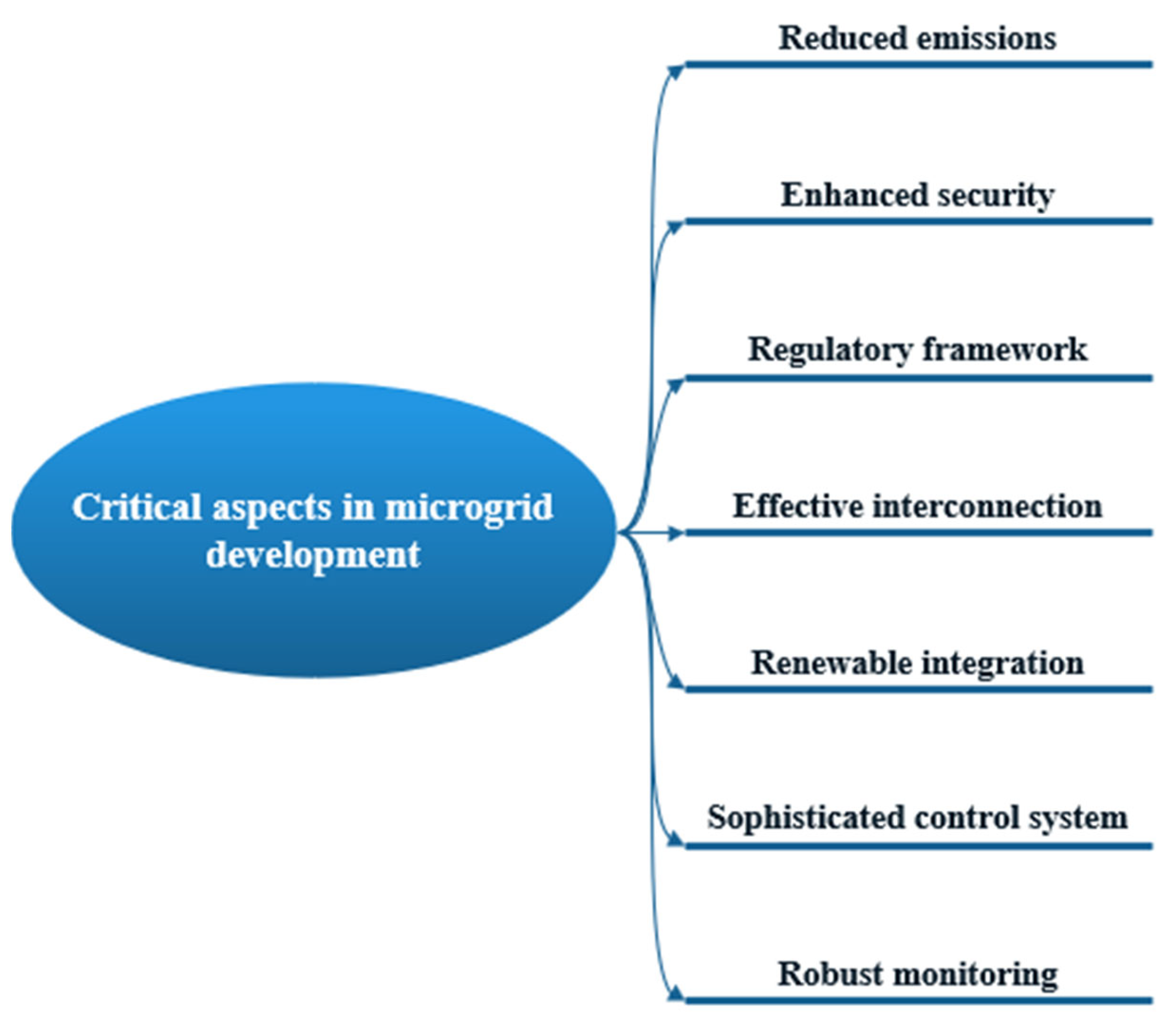
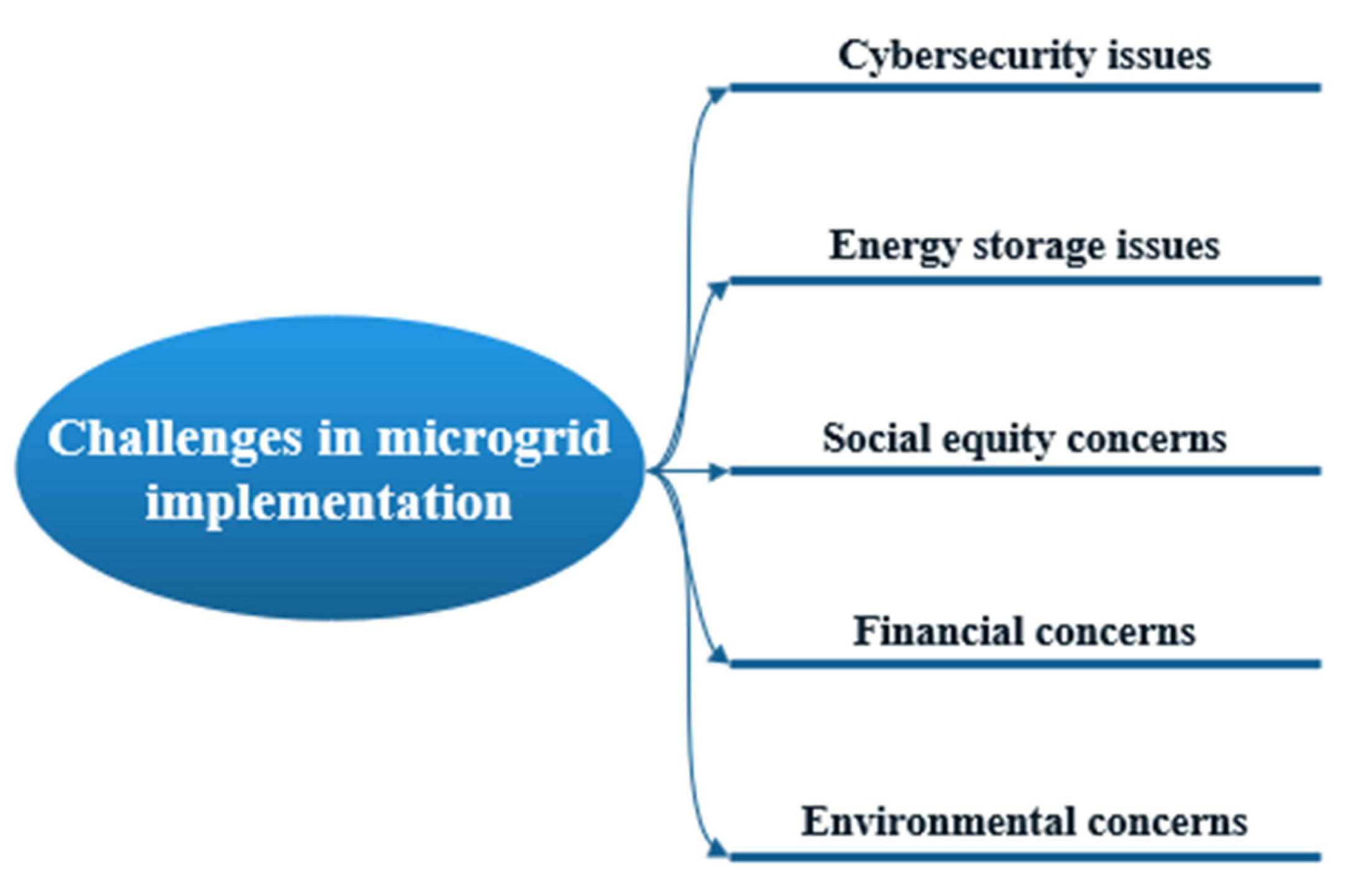
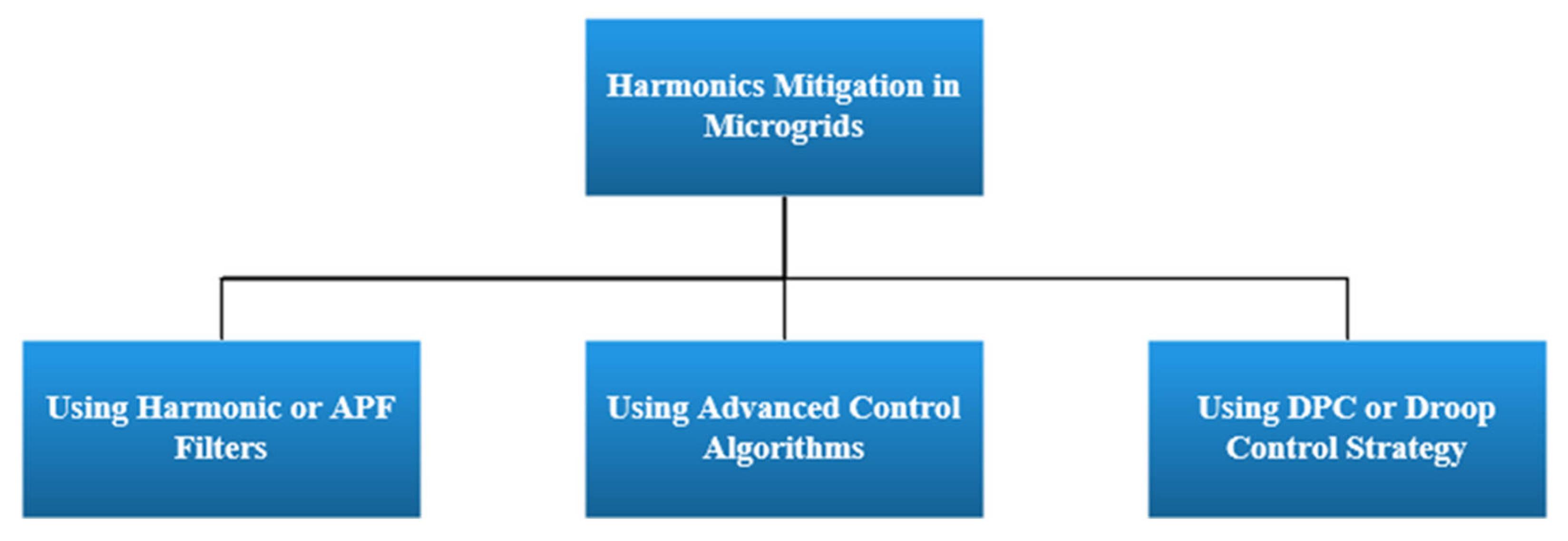
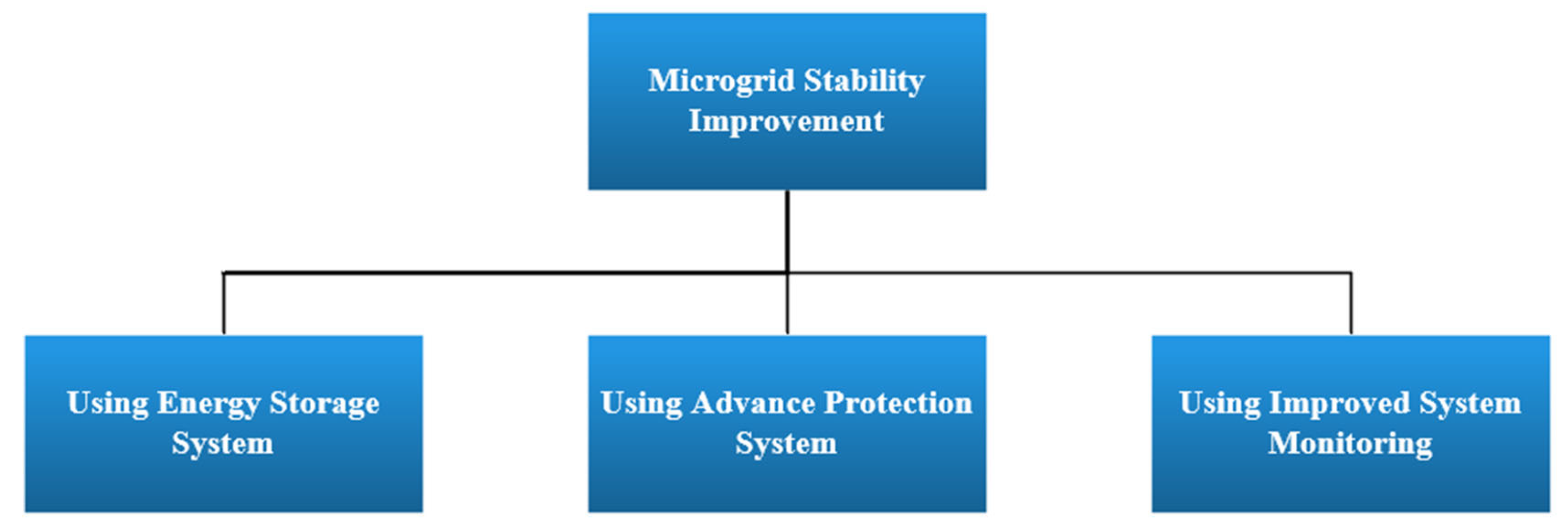

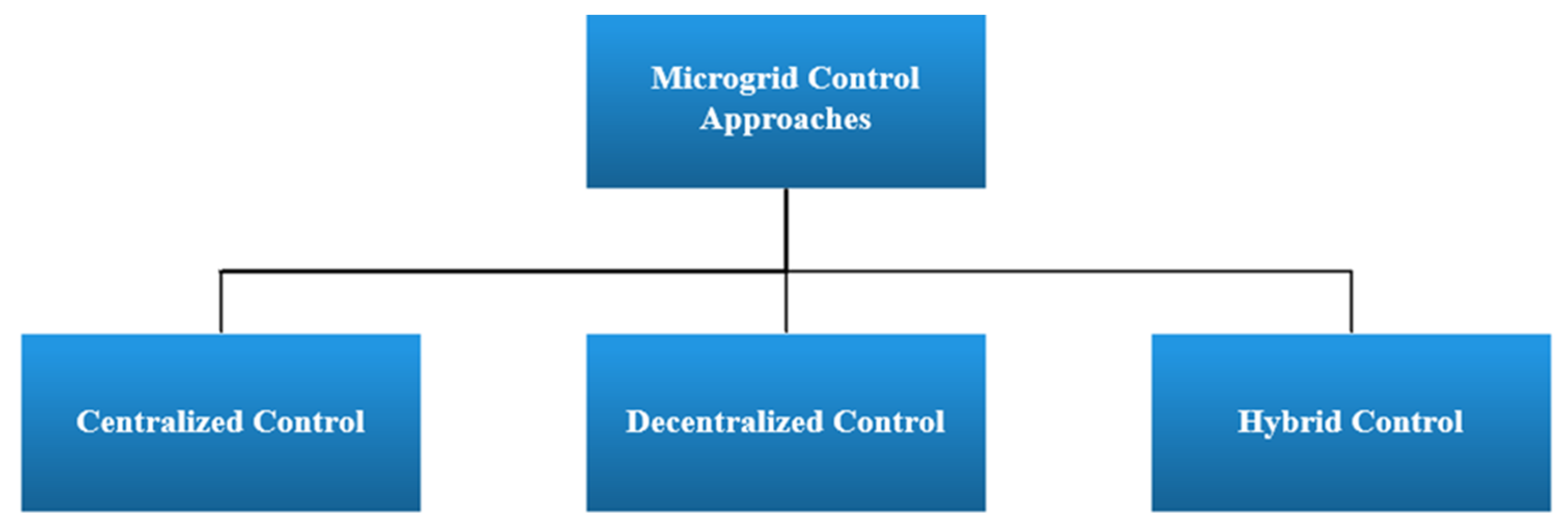

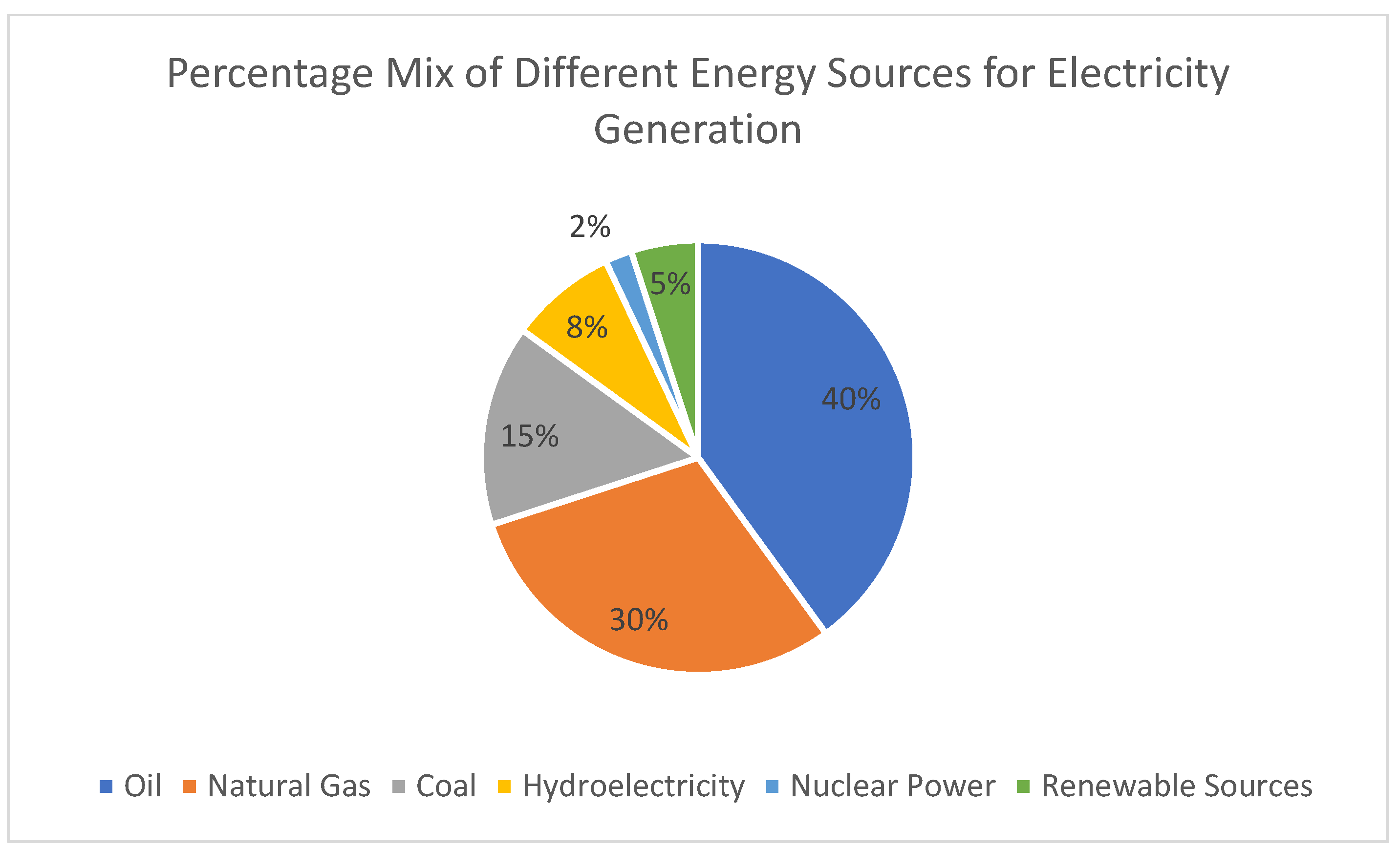
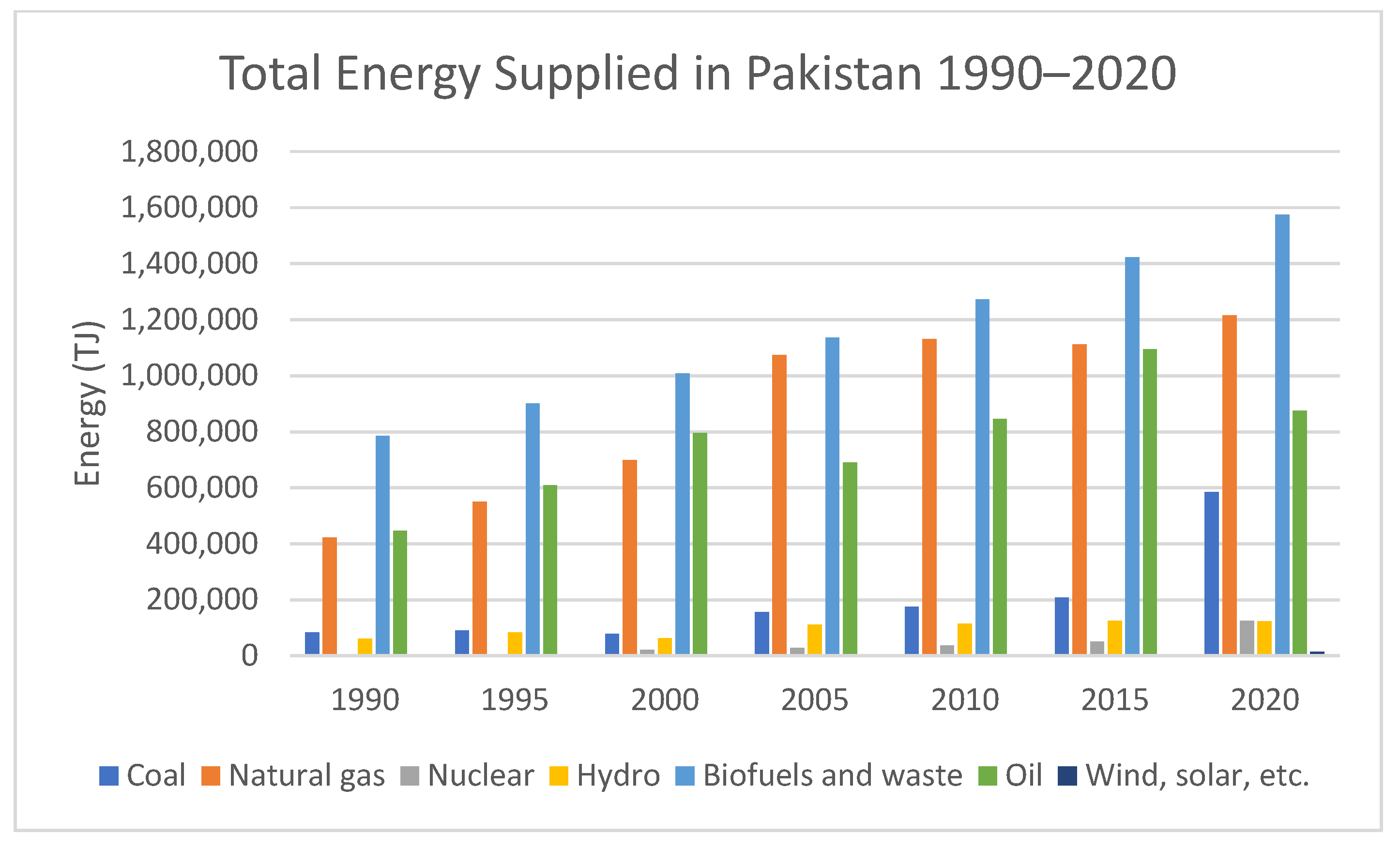
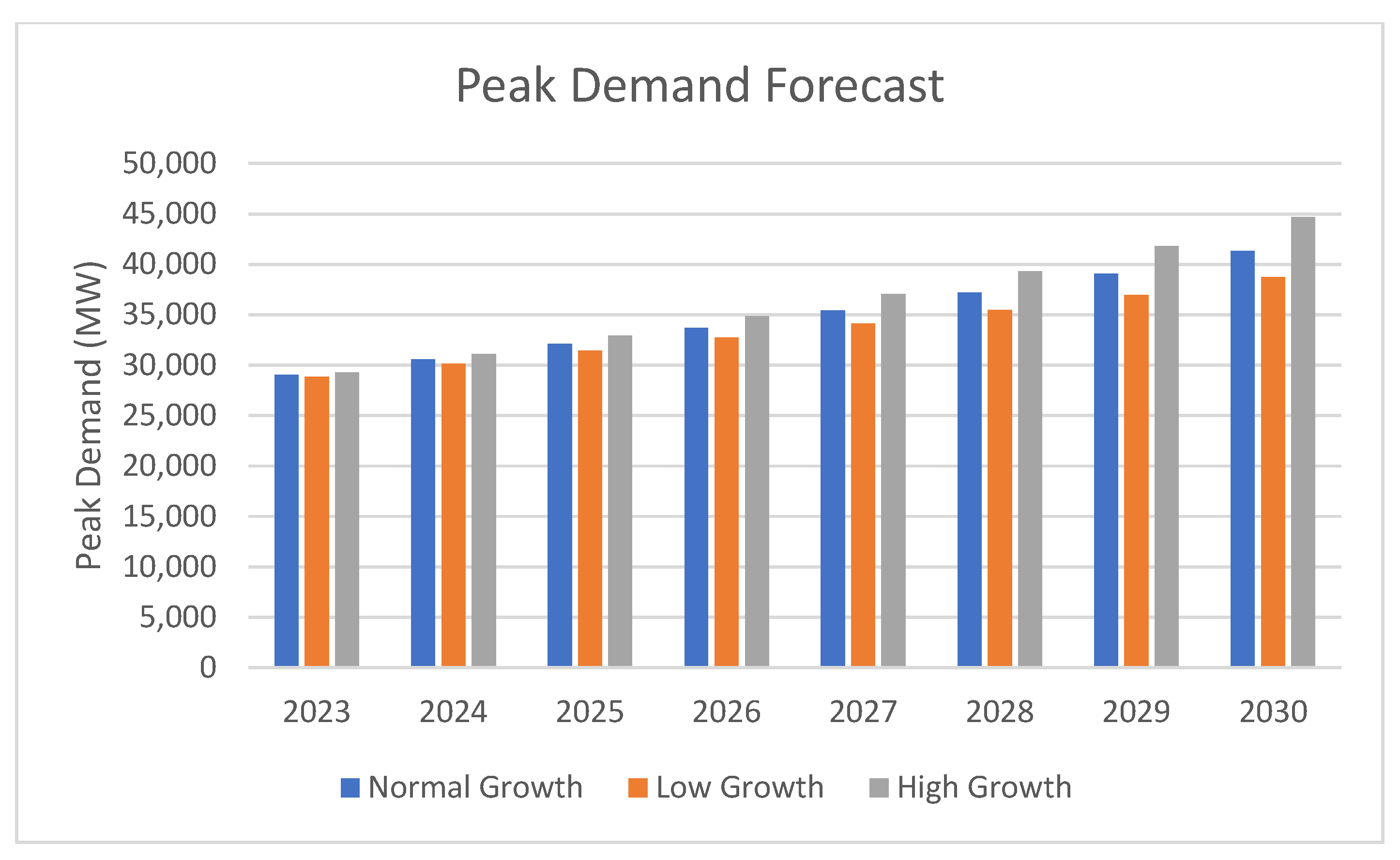

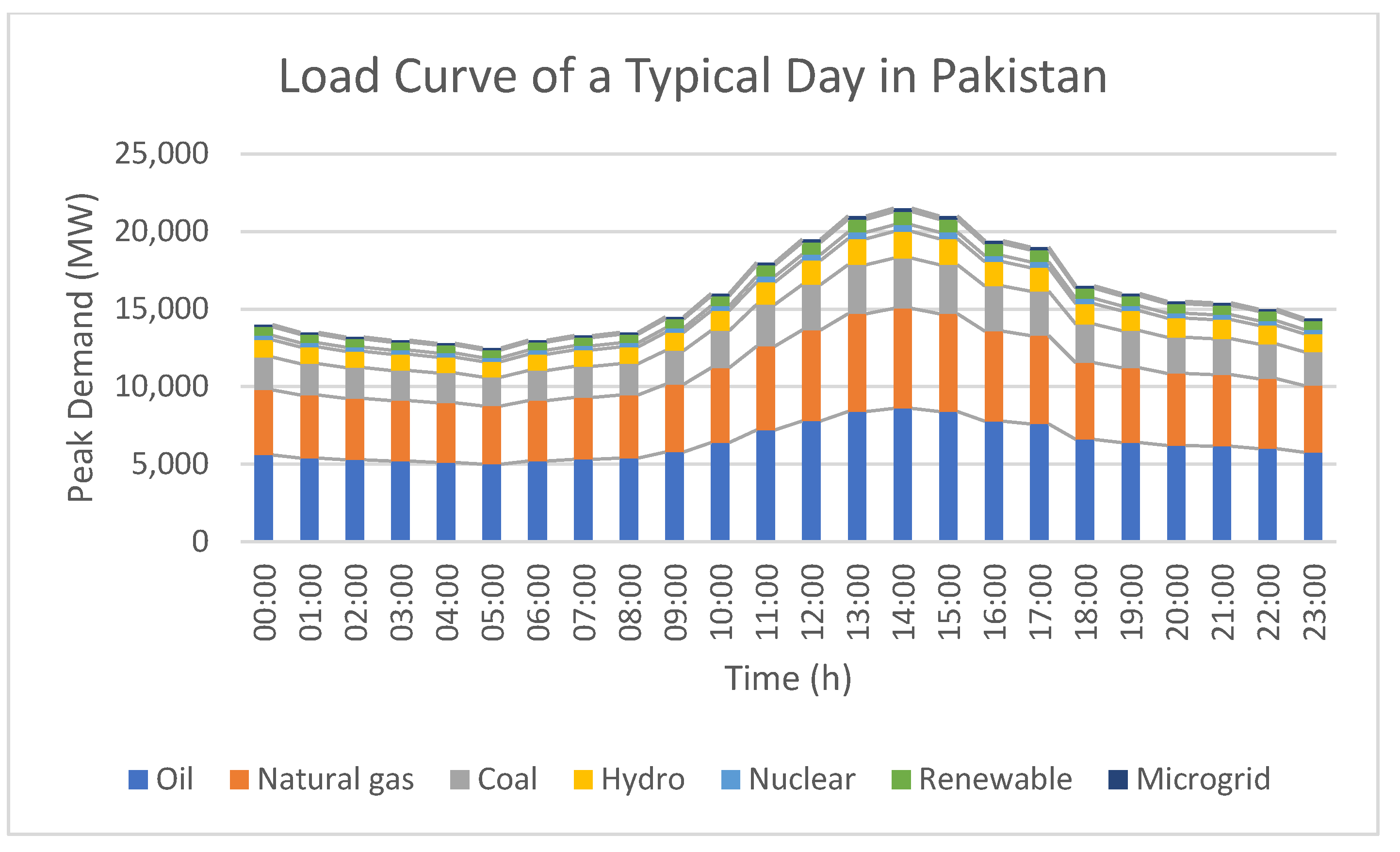

| Ref | Contributions | Limitations |
|---|---|---|
| [41] | This paper defines various stability parameters in microgrids and analyzes the various stability improvement strategies | A case study of microgrid stability analysis is missing |
| [42] | This paper explains various energy management strategies for developing a resilient microgrid | It lacks the review of machine learning techniques in microgrid energy management |
| [43] | This paper explains different energy management strategies with flexible energy sources | This paper does not present a review of super capacitors in microgrid energy management |
| [44] | This paper is a review of microgrids’ robust optimization with load uncertainty | It does not include the utilization of model predictive control strategies |
| [45] | This paper explains a number of energy management strategies at small-scale microgrids | It does not present the utilization of demand side management strategies |
| [46] | This paper is a review of microgrid architecture, control, and reliability | This paper lacks the implementation of microgrids at a nano scale |
| [47] | This paper is a review of microgrid cluster and operation | It lacks the information of grid level energy exchange |
| [48] | This paper performs reliability, economic, and environmental analysis of microgrid systems | It does not suggest a method to make a resilient microgrid system |
| [49] | In this work, various data-mining-based fault detection and classification strategies are studied | Information about the harmonic mitigation strategy is missing |
| [50] | In this paper, the implementation framework of a microgrid is studied | The strategies to mitigate the practical hurdles are missing |
Disclaimer/Publisher’s Note: The statements, opinions and data contained in all publications are solely those of the individual author(s) and contributor(s) and not of MDPI and/or the editor(s). MDPI and/or the editor(s) disclaim responsibility for any injury to people or property resulting from any ideas, methods, instructions or products referred to in the content. |
© 2023 by the authors. Licensee MDPI, Basel, Switzerland. This article is an open access article distributed under the terms and conditions of the Creative Commons Attribution (CC BY) license (https://creativecommons.org/licenses/by/4.0/).
Share and Cite
Shahzad, S.; Abbasi, M.A.; Ali, H.; Iqbal, M.; Munir, R.; Kilic, H. Possibilities, Challenges, and Future Opportunities of Microgrids: A Review. Sustainability 2023, 15, 6366. https://doi.org/10.3390/su15086366
Shahzad S, Abbasi MA, Ali H, Iqbal M, Munir R, Kilic H. Possibilities, Challenges, and Future Opportunities of Microgrids: A Review. Sustainability. 2023; 15(8):6366. https://doi.org/10.3390/su15086366
Chicago/Turabian StyleShahzad, Sulman, Muhammad Abbas Abbasi, Hassan Ali, Muhammad Iqbal, Rania Munir, and Heybet Kilic. 2023. "Possibilities, Challenges, and Future Opportunities of Microgrids: A Review" Sustainability 15, no. 8: 6366. https://doi.org/10.3390/su15086366
APA StyleShahzad, S., Abbasi, M. A., Ali, H., Iqbal, M., Munir, R., & Kilic, H. (2023). Possibilities, Challenges, and Future Opportunities of Microgrids: A Review. Sustainability, 15(8), 6366. https://doi.org/10.3390/su15086366







